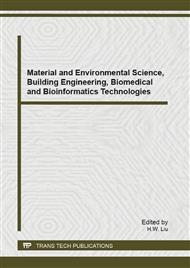[1]
Delia Soimu, A novel approach for distortion correction for X-ray image intensifiers, Computerized Medical Imaging and Graphics. 27(2003) 79-85.
DOI: 10.1016/s0895-6111(02)00055-1
Google Scholar
[2]
J. Sauvola, M. Pietikainen, Adaptive document image binarization, Pattern Recognition 33 (2000) 225–236.
DOI: 10.1016/s0031-3203(99)00055-2
Google Scholar
[3]
B. Gatos, I. Pratikakis, S.J. Perantonis, Adaptive degraded document image binarization, Pattern Recognition. 39 (2006) 317–327.
DOI: 10.1016/j.patcog.2005.09.010
Google Scholar
[4]
Quanfa Zhang, Goran Pavlic, Wenjun Chen, A semi-automatic segmentation procedure for feature extraction in remotely sensed imagery, Computers & Geosciences. 31 (2005) 289–296.
DOI: 10.1016/j.cageo.2004.10.003
Google Scholar
[5]
Torbjørn Sund, Karsten Eilertsen, An Algorithm for Fast Adaptive Image Binarization With Applications in Radiotherapy Imaging, EEE TRANSACTIONS ON MEDICAL IMAGING. 22(1)(2003)22-28.
DOI: 10.1109/tmi.2002.806431
Google Scholar
[6]
Kenji Suzuki, Isao Horiba, Noboru Sugie, Linear-time connected-component labeling based on sequential local operations, Computer Vision and Image Understanding. 89(2003) 1–23.
DOI: 10.1016/s1077-3142(02)00030-9
Google Scholar
[7]
Yang Yang, David Zhang, A novel line scan clustering algorithm for identifying connected components in digital images, Image and Vision Computing. 21(2003)459–472.
DOI: 10.1016/s0262-8856(03)00015-5
Google Scholar
[8]
Fu Chang, Chun-Jen Chen, Chi-Jen Lu, A linear-time component-labeling algorithm using contour tracing technique, Computer Vision and Image Understanding. 93(2004) 206–220.
DOI: 10.1016/j.cviu.2003.09.002
Google Scholar
[9]
YAN Shi-ju, WANG Cheng-tao, CHEN Tong-yi, Application of a Fast Connected Components Labeling Algorithm in Processing Landmark Images, Journal of Shanghai Jiaotong university. 12(3) (2007) 383-387.
Google Scholar
[10]
Chung, K.L., Huang, H.L., Chen, I.C., 2003. New two-phase spatial data structures with applications to binary images. J. Vis. Commun. Image R. 14 (2), 97-113.
DOI: 10.1016/s1047-3203(03)00021-x
Google Scholar


